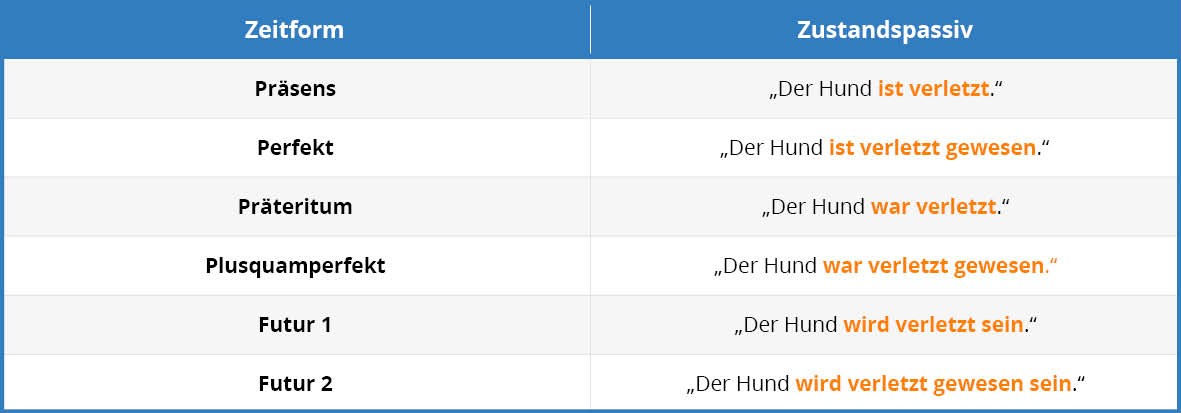German Passive Voice
Das Passiv im Deutschen – Erklärungen und Beispiele
German Passive Voice – Summary
Zusammenfassung
People can behave in an active or a passive way. In order to describe the condition in a better way, there are linguistic ways to express them.
- Active Voice: “Philip sieht den Hund.”
- Passive Voice: “Der Hund wird von Philip gesehen.”
Be careful – not every verb has a form in the passive voice. So, verbs that don’t have an accusative object are called intransitive. The verb that have a form in the passive voice and an accusative object are called transitive.
Forming the Passive Voice
Let’s look at a simple sentence in the active voice with a subject (S), a verb (V) in the present tense and an object (O) in the fourth case.
- Active Voice: “Philip sieht den Hund.”
Subject S = “Philip”, Verb V = “sieht”, Object O = “den Hund”.
This sentence in the active voice turns into passive voice by three changes:
- The object (“den Hund”) becomes the subject.
- The verb is replaced by the adapted form of the auxiliary verb and the main verb of compound tense.
- The subject becomes the object in the third case (“von Philip”).
- Passive Voice: “Der Hund wird von Philip gesehen.”
Welcome to language-easy.org! Well, as you have chosen this article, I suppose that you want to enter deeply in the world of German grammar and learn something about German passive voice. So, this part of the German language is, of course, of high importance. Nevertheless, the German passive voice is not used as frequently as in the English language.
However, you should know how to master this grammar topic, as it is essential for understand news reports in newspapers and television. Furthermore, a lot of neutral reports in working contexts are written in the German passive voice. So, even though this part of German grammar might be difficult sometimes, but its high importance should encourage you to study hard.
Well, German is rather complicated language – There are a lot of exceptions which you can only master by studying hard. But think of the huge world of German culture and all the other possibilities that will open when you dominate this language.
So, let’s not lose too much time and go straight forward to the first part of this article. Well, we will talk about what German passive voice actually is. After that, we will try to clear up how German passive voice is used in the correct kind of way.
And now… Los geht’s!
Definition and Usage of German Passive Voice
Die Definition und Anwendung des Passivs im Deutschen
First of all, we will have to clear up what the German passive voice actually is. So, there are two types of German passive voice which we will define in the following.
1. The Processual Passiv
First, there is the processual passive (Vorgangspassiv) which is conjugated with the verb “werden”. So, this type of German passive voice emphasizes an action. Well, let’s use and example phrase to show what that means.
- “Der Hund wurde angefahren” – The dog was run down.
Here, you can clearly see the emphasis on the action.
2. The Statal Passiv
Second, we have the statal passive (Zustandspassiv) which is conjugated with the verb “sein” and emphasizes a condition. So, here is another example phrase that show the correct usage of this type of German passive voice.
- “Der Hund is verletzt” – The dog is hurt.
Obviously, the condition of the dog is described and not the action of hurting him.
Of course, and absolutely typical for the passive voice, who or what caused the action or condition is either not important, unknown or assumed to be general knowledge. Well, as we have cleared up the two basic principles of German passive voice, we will now talk about its conjugation.
The Conjugation of German Passive Voice
Die Konjugation des Passivs im Deutschen
Now, we will come to the central part of this article about German passive voice. So, we will talk about the conjugation of both types of German passive voice and have a detailed look on their structure and some examples.
1. The Processual Passive Voice
First, let’s have a look at the conjugation of the processual passive in German. Well, as already mentioned, we need a form the auxiliary verb “werden” and the past participle of the full verb. Luckily, there is a simple rule for is structure:
Subject + form of “werden” (+ object) + past participle
So, not too difficult, isn’t it? And, to make it even easier to understand for you, let’s look at the following table with the conjugation of this kind of German passive voice in all German tenses.

Now, as we have cleared up how to form this type of German passive voice, let’s come to the next one and talk about it’s forms in different tenses.
2. The Statal Passive
Second, we will have a look at the forming of the second type of German passive voice, the statal passive. Of, there is also a formula quite similar to the other type of German passive. Well, the only difference is that we need a form of “sein” and the past participle of the full verb. So, here is the rule.
Subject + form of “sein” + past participle
Now, we will illustrate what this formula means in the following table. Of course, we will have a look the conjugation in the 3rd person singular in all German tenses.

Active or Passive Voice?
Aktiv oder Passiv?
Now, we have reached the final point of this article. Well at this point we will have to clear up whether to use the active of German passive voice. Of course, all of you know that we use the active form to emphasize who or what is performing an action.
Furthermore, the German passive voice is used to emphasize the action itself. Here, who or what is performing is often left in passive sentences.
Unfortunately, we are learning German. And this means, that there are exceptions! Well, actually it’s not too complicated, so, don’t worry. Well, there are simply some kinds of verbs that can’t be expressed in the German passive voice. In the following, we will have a closer look at these verb groups.
1. Verbs whose Present Perfect Form takes “sein”
So, this is the first group of verbs that can’t be expressed in the passive. Well, an example for this group of verbs would be “fahren” (to drive).
2. Reflexive Verbs
Second, there are reflexive verbs which can not be expressed in the passive voice. Of course, all of you know that reflexive verbs always take a reflexive pronoun. Well, an example would be “sich beschweren” (to complain). By the way, just click on the link above for some more information about reflexive verbs.
3. Other Verbs without Accusative Object
Unfortunately, there is another broad group of verbs, that can’t be expressed in German passive voice. Here, “schlafen” (to sleep) would be a good example. Others are “haben” (to have), “kennen” (to know), “es gibt” (there is).
4. Examples German passive voice vs. active voice

Exercises
Übungen
Finally, we have reached the last part of this article where you can prove the German skills you have just learned. In the following you will see some phrases that you should complete with the correct terms. Once you have filled all the gaps, just click on the “correct” button and you can see your errors and the correct results. Good luck and… auf Wiedersehen!



